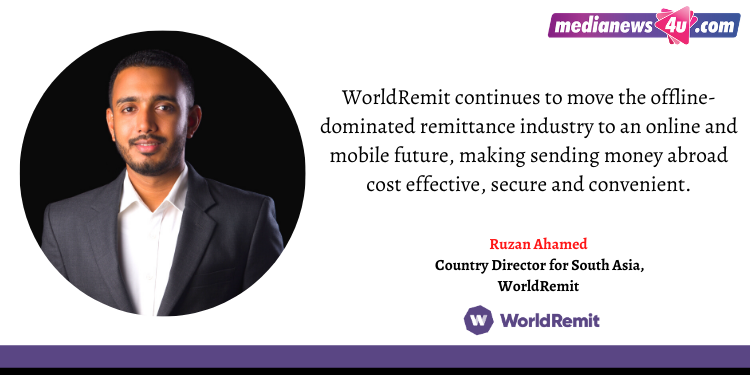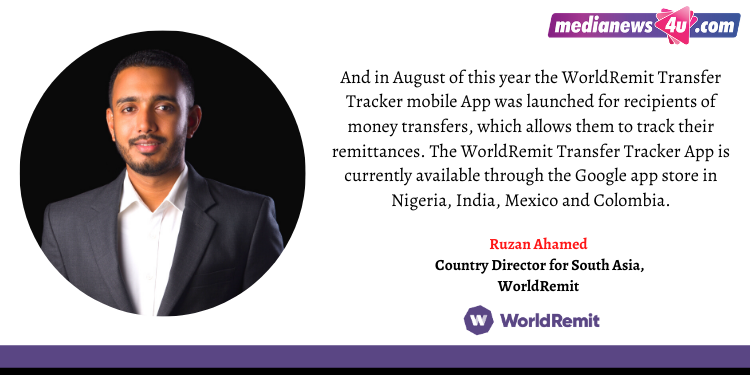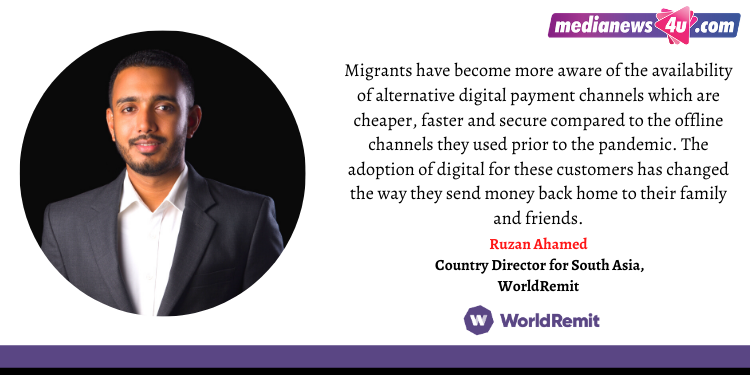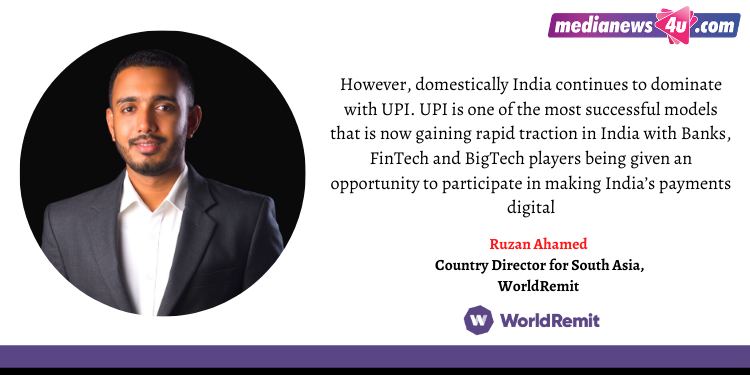WorldRemit, is the global leader in mobile money payments. Since its inception in 2010, the company has grown exponentially globally and taken on remittance giants like Western Union and MoneyGram to be top 5 remittance company and the top mobile money transfer company.
In an exclusive chat with MediaNews4U, Ruzan Ahamed, Country Director for South Asia, World Remit, talks about the changing landscape in the money remit business and much more.
WorldRemit was launched in 2010, how has the journey been?
Since launching WorldRemit 10 years, where we disrupted an industry dominated by offline legacy players, it has been a challenging but rewarding journey. WorldRemit was founded in 2010 by Ismail Ahmed, a migrant from Somaliland to solve the inconvenience and expense of sending money back home to his family through traditional money transfer companies.
Today, the majority of World Remit’s customers are migrants from the developing world living in developed countries sending money home to support their family and friends.
We have expanded our digital cross-border payments into 50 send markets and built an expansive network in 150 receive countries, operating in 6,500 money transfer corridors worldwide, and we are still growing. Our team is truly global with 1,100 employees located around the world supporting more than 6 million customers.
WorldRemit continues to move the offline-dominated remittance industry to an online and mobile future, making sending money abroad cost effective, secure and convenient.

Backed by Accel, TCV and Leapfrog – WorldRemit’s headquarters are in London, United Kingdom with regional offices in the United States, Canada, Australia, New Zealand, Hong Kong, Singapore, Malaysia, the Philippines, South Africa, Somaliland, Uganda, Kenya, Rwanda, Tanzania, Zimbabwe and Belgium.
There are a plethora of payment apps. How different is WorldRemit?
On the sending side, World Remit is 100% digital (cashless), increasing convenience and enhancing security. WorldRemit offers transparency in what fees it charges, meaning our fees are upfront with no hidden costs, and the receivers receive their remittances within minutes. We also offer competitive exchange rates where we recently launched preferential rates for customers who send more within one transaction. And in August of this year the WorldRemit Transfer Tracker mobile App was launched for recipients of money transfers, which allows them to track their remittances. The WorldRemit Transfer Tracker App is currently available through the Google app store in Nigeria, India, Mexico and Colombia.

The pandemic and lockdown has seen a surge in digital payments, how do you see this trend?
The fall out of COVID-19 has created significant opportunities for businesses to embrace innovation and evolve at an accelerated pace to navigate and emerge from this crisis well-positioned for the future. The International Monetary Fund (IMF) recently indicated1. That low-income households (and small firms) are benefiting greatly from advances in mobile money, fintech services, and online banking. The pandemic shows that the trend towards greater digitalisation of financial services is here to stay.
With the shift to digital due to lockdown restrictions imposed on many countries, minimising contact and the ability to be able to physically receive cash, many people have shifted towards a preference of receiving funds directly into their Bank accounts or mobile wallets. Migrants have become more aware of the availability of alternative digital payment channels which are cheaper, faster and secure compared to the offline channels they used prior to the pandemic. The adoption of digital for these customers has changed the way they send money back home to their family and friends.

How different is the mind-set in the other regions like Nepal, BD, Sri Lanka and Pakistan toward digital payments in comparison to India?
Across Nepal, Bangladesh, Sri Lanka and Pakistan the mind-set of customers in terms of the shift to digital is the same compared to India. WorldRemit has seen a significant uptake in volumes as customers have moved from informal channels to formal digital channels, due to the lockdowns imposed restricting movement. In particular Pakistan, Bangladesh and Nepal saw record number of inward remittances over the past few months as the senders was moving away from informal to formal channels to send money back home to their loved ones.
However, domestically India continues to dominate with UPI. UPI is one of the most successful models that is now gaining rapid traction in India with Banks, FinTech and BigTech players being given an opportunity to participate in making India’s payments digital. This platform that allows P2P transfers and retail payments has grown significantly over the past few months and has attracted many big players to join the platform.

Statistics:
- UPI crossed 2 Billion monthly transactions in Oct 2020 (Moving INR 3.2 trillion through the system). 80% increase YOY
- 189 Banks are now on the platform broadening the access to the masses in India
- UPI transactions grew since lockdown was imposed but did not go down when lockdown was lifted. Instead it grew more.
NOTE: Reference sources to the above
https://entrackr.com/2020/11/upi-set-to-create-a-new-record-in-november/
In some markets, the push to go digital is now prioritised with government incentives such as Pakistan. In March The State Bank of Pakistan instructed Banks to waive all charges on fund transfers through digital channels.
How have you gone about marketing WorldRemit?
We have a long history of building financial inclusion, one transaction at a time. And, we have purposefully focused on markets that others have not been able to serve. The platform was purpose-built for cross-border financial transactions. So it is our mission to connect people and their money by using technology to simplify financial services. We communicate to our 6 million-plus customers in both the send and receive markets via all marketing channels across digital, online and offline including grassroots events and campaigns, whereby we focus on corridor-specific holidays and celebrations of significance. For Diwali this year we launched a win a tablet promotion for those sending from Australia and New Zealand. This Diwali campaign was marketed via our social media channels, mobile marketing, advertising on relevant Indian streaming platform and via the local and ethnic media publications.

















